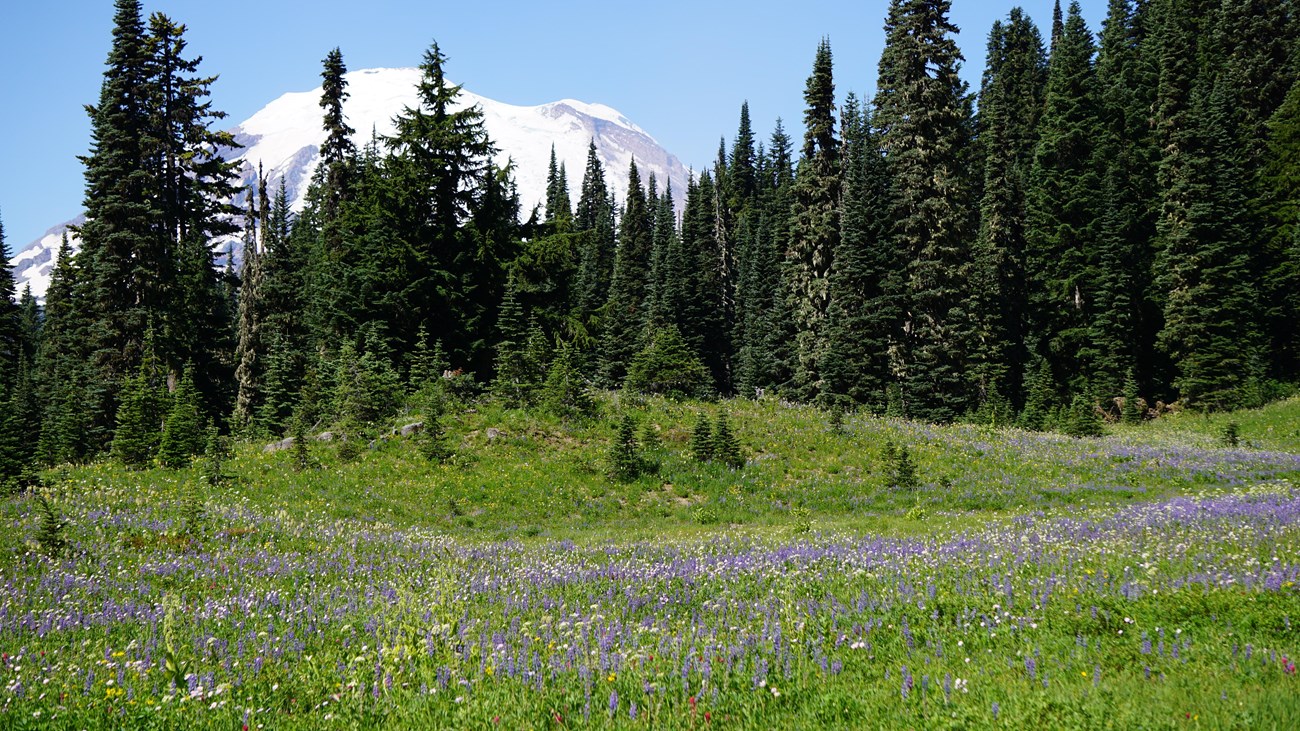Last updated: June 3, 2021
Thing to Do
Discover Wildflowers

NPS Photo
Mount Rainer's renowned subalpine wildflowers bloom for a limited amount of time every year. The "peak" bloom for wildflowers is heavily dependent on weather and precipitation patterns, so accurate predictions are difficult. In most years, many flowers will be blooming by mid-July, and by the first of August the meadows should be very impressive. Frost can occur by late August, but even after light frosts the meadows continue to be very beautiful, thanks to changing leaf colors and seed development that take the place of colorful blossoms.
Though some overlap occurs, forest and subalpine areas of the park host distinct groups of wildflower species. Dense old growth forest creates cool, shady conditions suitable to wildflower species different from the ones found in the sunnier subalpine meadows. Forest covers the low-to-mid elevations of the park from approximately 2,000 to 4,500 feet (610-1372m). Subalpine meadows wreath the higher elevations of Mount Rainier, from about 4,500 to 6,500 feet (1372-1981 m). This region is sometimes called subalpine parkland because trees start to thin out and grow in patches interspersed among the meadow instead of continuous forest. Eventually trees disappear completely in the alpine zone starting from approx. 6,500 feet (1981 m) to the summit. Subalpine regions often have the most impressive wildflower displays because those regions have a very short growing season.
To learn about some of Mount Rainier’s wildflower species, check out the online Wildflower Guide. For identification of flowers in the field, you can download the Mount Rainier Wildflower site bulletin, ask a ranger, or purchase a variety of wildflower identification guidebooks available in the park visitor centers and gift shops.
Please stay on the trails. As snow melts away, it may be tempting to skirt remaining patches of snow that are covering trails. However, by going off trail you are walking on and damaging the wildflowers that you may be coming to see! It is better to stay on the trail even if that means crossing snow, particularly in the high-visitation meadows around Paradise and Sunrise. Also, there are plenty of opportunities for the perfect mountain + wildflower photo from the trails! No need to step off trail and crush other flowers in your quest for the perfect shot.
Discover Wildflowers
To find out what’s blooming where, check the Discover Wildflowers webpage during the summer months for wildflower reports. Or use this reference as a quick overview of when common wildflowers may be blooming.
May
Subalpine meadows are still under many feet of snow. However, depending on conditions, low elevation forest wildflowers are beginning to emerge. Look for skunk cabbage (Lysichiton americanus), western trillium (Trillium ovatum), and sweet coltsfoot (Petasites frigidus).
June
Many low elevation forest wildflowers may be blooming. Common forest wildflowers include vanilla leaf (Achlys triphylla), Cascade Oregon-grape (Berberis nervosa), foam flower (Tiarella trifoliata), bunchberry (Cornus canadensis), and a variety of violets (Viola ssp.).Subalpine meadows are melting out but are still covered in patches of snow. Early subalpine wildflowers include avalanche lily (Erythronium montanum), glacier lilies (Erythronium grandiflorum), pasqueflower (Anemone occidentalis), and western spring beauty (Claytonia lanceolara var. lanceolata).
July – August
Patches of snow can linger well into July, but by late July to early August, the subalpine meadows are usually in peak bloom. Numerous wildflower species bloom simultaneously to compete for pollinators during the short growing season. Common subalpine wildflowers include paintbrushes (Castilleja spp.), louseworts (Pedicularis ssp.), penstemons (Penstemon ssp.), broadleaf lupine (Lupinus latifolius), American bistort (Polygonum bistortoides), Sitka valerian (Valeriana sitchensis), subalpine daisy (Erigeron peregrinus), and Cascade aster (Eucephallus ledophyllus).
September
Most subalpine wildflowers are becoming seed heads and meadow vegetation is starting to turn red, orange, and yellow with fall color. Some late blooming wildflowers include pearly everlasting (Anaphalis margaritacea) and mountain bog gentian (Gentiana calycosa). Also look for the bright red berries of Sitka mountain ash (Sorbus sitchensis).
October – April
Mount Rainier is one of the snowiest places on earth, receiving on average over 630 inches of snow every year. All this water helps fuel the dense vegetation growing on the mountain, including numerous wildflowers.
Changing climate patterns, including warmer winters with more rain instead of snow, may affect the timing of wildflower blooms. Scientists have partnered with volunteers to track wildflower blooming times at Mount Rainier National Park. Learn more and get involved at MeadoWatch.
